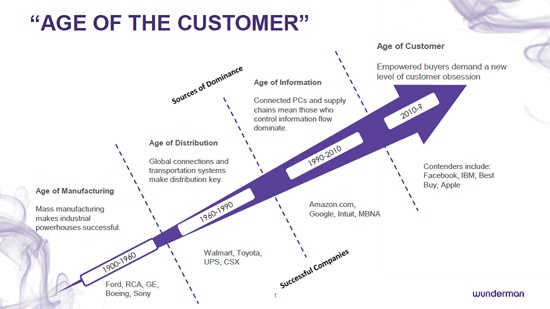It was an honor to attend the Customer Experience Leadership Conference hosted by The Conference Board in New York City. Not only was the weather perfectly pleasant in NYC that week, but the caliber of speakers at this event was also outstanding! Coming from a company that supports our clients with strategic consulting on the customer experience, it was a beautiful sight to see great minds across a breadth of industries coming together to discuss how to improve their customers’ experiences.
The Changing Tide
The reason to attend this event in the future is articulated well by this model (by wunderman). We are now in the "Age of the Customer."
The Dilemma
Having the best product, the best price, the best availability, and/or the best marketing/PR campaign isn’t enough anymore. Customers’ expectations are constantly evolving and companies that survive this next generation will clearly express a value proposition to their customers that is experiential. It has to be meaningful in its delivery and create positive memories that will last indefinitely to instill brand loyalty.
Conference Themes
The themes revealed through the presentations, the lunch table conversations, and the questions that were asked of the presenters centered on the following critical topics:
1. Companies that lead in their industries have a growing concern that they are falling behind on the customer experience and need to begin a transformation of their own
- But where do they start? And what process should they follow?
2. Customer expectations are being formed based on premier service providers like Whole Foods, Disney, Virgin Atlantic, and American Express.
- Regardless of your industry, these top players in their industries are forming your customers’ expectations too.
3. Brand “storytelling” is becoming an art form that requires new organizational skill sets. It must communicate the brand story through many mediums using a multi-faceted approach that will ultimately showcase your brand from the inside out.
- The audience isn’t just customers. When done effectively, it should reach the hearts and minds of your employees, your prospects, your partners, and your customers.
The Solutions
If you are embarking on a similar initiative, these solutions should be useful. References to the following key aspects of transforming your customer experience were found in almost every presentation:
1. The need for an inspiring and clear vision
The whole organization has to be on board and buy in to the need for change. People need to understand why the change is happening now, and it needs support from senior management. Without an inspirational message that clearly articulates where the organization is headed and why it’s heading there, sustained, permanent change won’t prevail.
2. Employee engagement
Employees need to feel like they are a part of solving the problem. They need to be engaged from the beginning as the customer experience really lies in the hands of frontline staff. Every point of customer contact must be consistent with the organization’s new vision. High involvement from all levels, especially leaders and supervisors, is critical. Their commitment to making this happen, understanding of the expectations and ownership of the results are the only ways that a cultural change will occur to support the transformation.
3. Reject silos
Organizational silos are the biggest barrier to delivering a superior customer experience. Without collaboration and sharing of information across departments and functional areas, innovation is stunted. In particular, the strength of collaboration on the use of new and emerging technologies when Information Technology (IT) departments are engaged and involved is essential. Without the ability to use technology to leverage big data and analytics, organizations will miss opportunities to deliver the ideal customer experience.
4. Tools to measure outcome/results
The tools to measure results are a critical component of the transformation process. The ability to point to a scoreboard at select intervals in time and say, “Hey, look! It’s working. We’re winning!” is important, because celebrating those successes is what will drive and reinforce the commitment needed from the organization. Presenters at the conference mentioned a myriad of tools that they use as the “scoreboard” including surveys, mystery shops, rewards/incentive programs, profit sharing plans and many more.
The Time is Now
So, if you are not already thinking about how you need to evolve your organization’s customer experience to meet this changing tide, the time is now.
For more information, including the most effective market research tactics for managing your customer experience, contact trustedinsight@trendsource.com.



